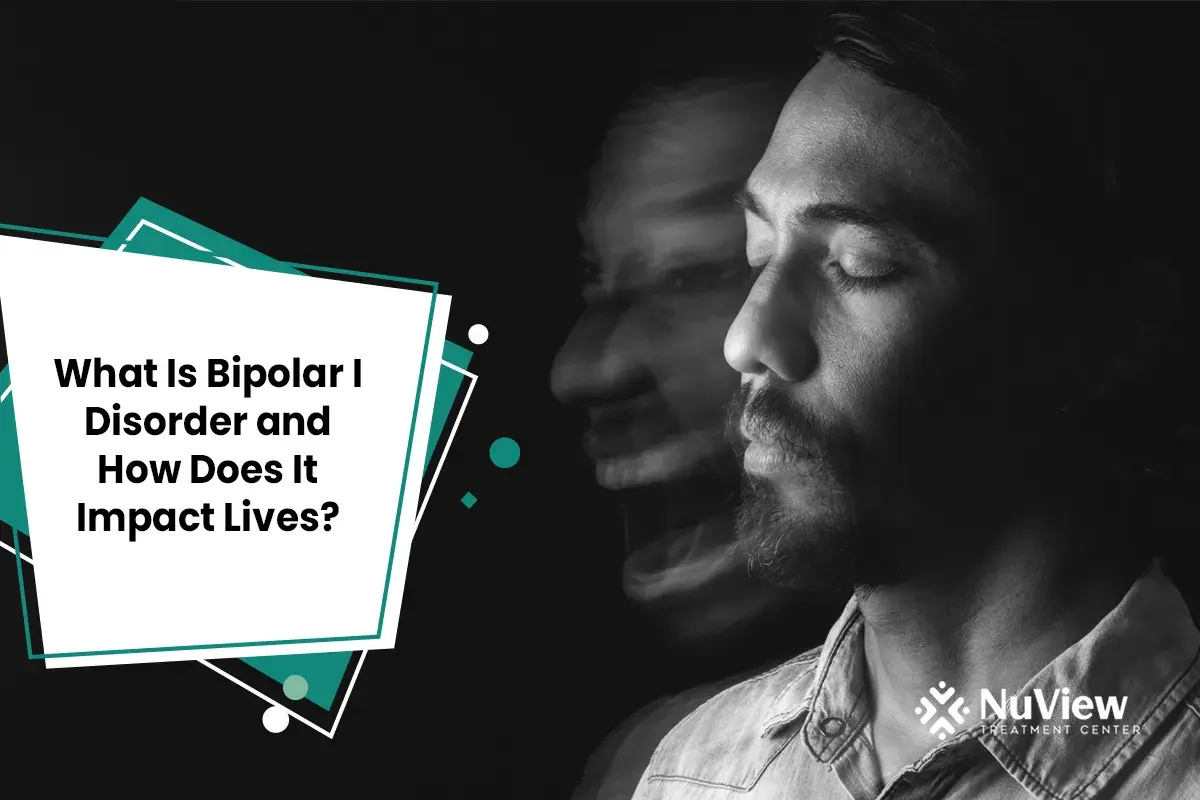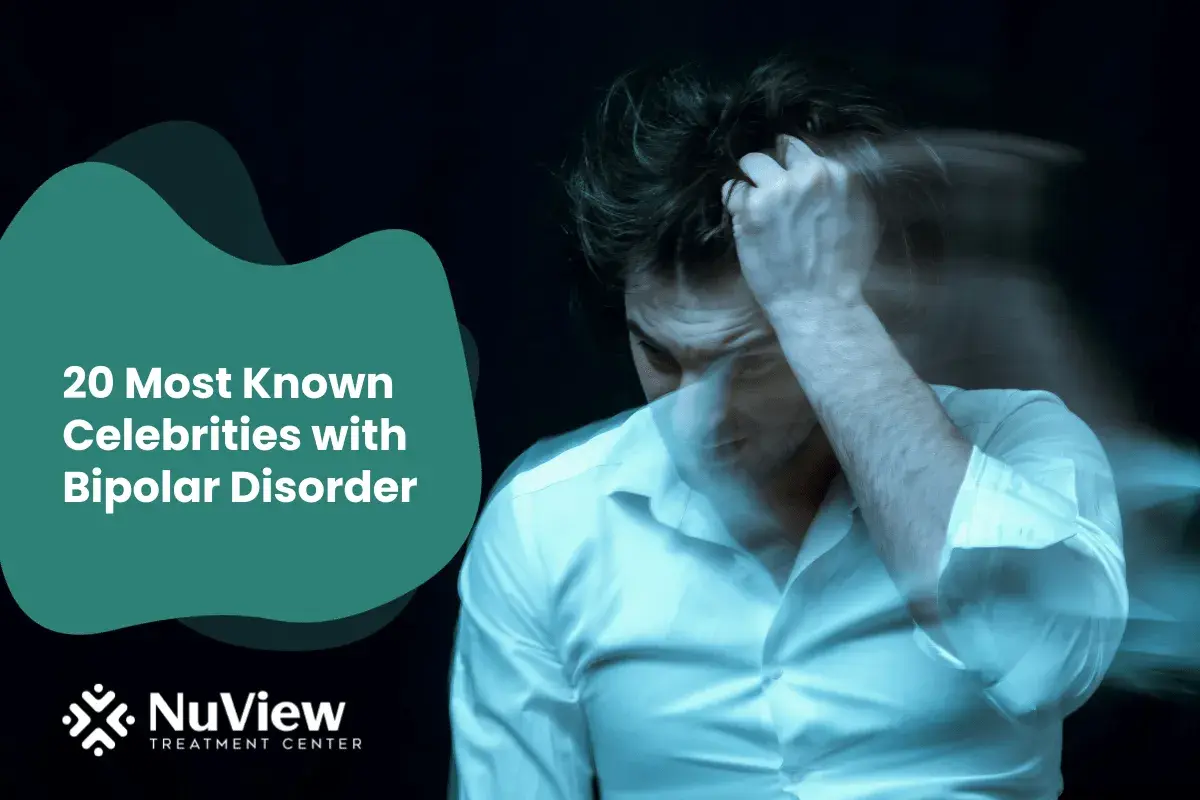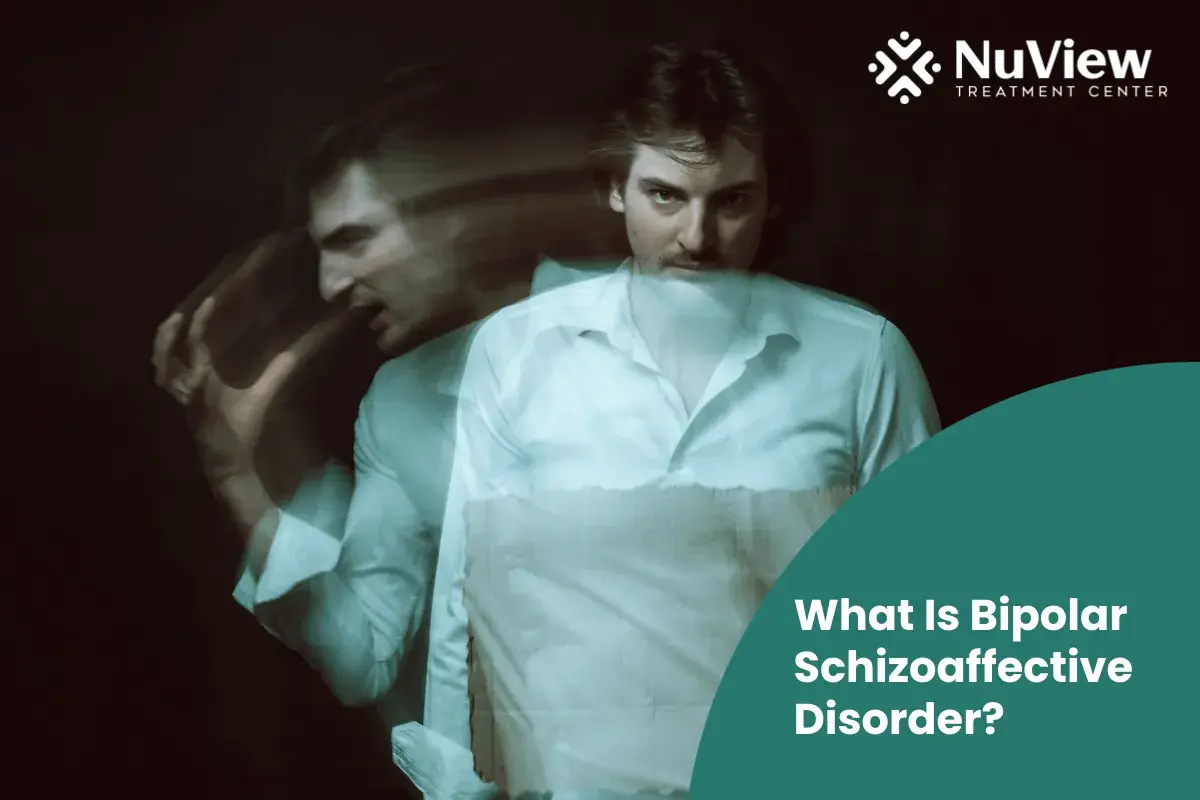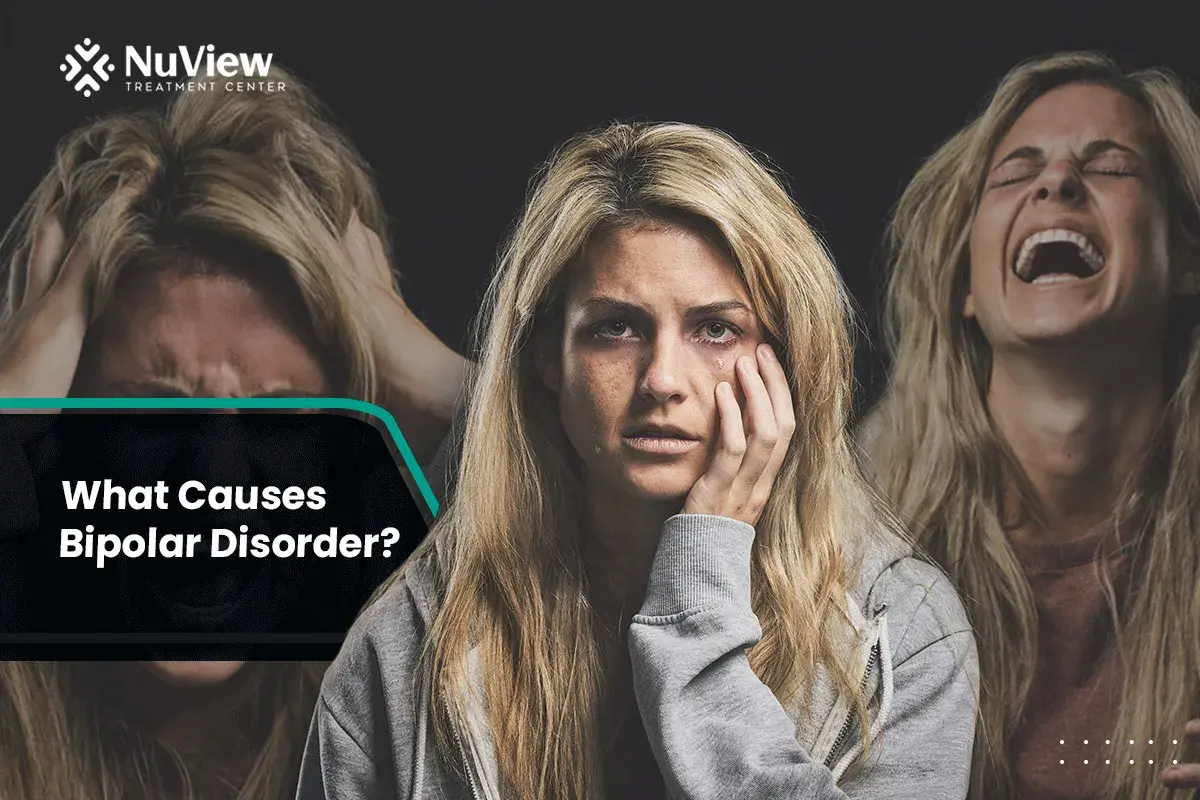Bipolar disorder is a mental health condition characterized by extreme mood swings, oscillating between high-energy phases and deep periods of sadness. A recent study conducted in clinical settings showed that 21.3% of patients prescribed antidepressants to treat their depression tested positive for symptoms indicative of bipolar disorder, according to the Mood Disorder Questionnaire (MDQ).
Bipolar I disorder, often manic-depressive, is one of the types of bipolar disorder. It's a rollercoaster of emotions that can leave individuals and their loved ones struggling with profound challenges.
This disorder is characterized by dramatic and often uncontrollable shifts between manic highs and depressive lows, and its impact on lives can be overwhelming.
What is Bipolar 1 Disorder?
Bipolar 1 Disorder is a complicated mental health condition characterized by significant mood swings, known as episodes. There are two primary types of episodes within this disorder:
- Manic Episodes:
During a manic episode, individuals who develop bipolar disorder experience a heightened and sometimes irrationally elevated mood. They may feel an abundance of energy, creativity, and self-confidence. While these feelings can be enjoyable, they often lead to impulsive and risky behaviors, such as excessive spending, reckless driving, or poor decision-making. Manic symptoms of bipolar disorder can disrupt everyday life, strain relationships, and, in some cases, require hospitalization.
- Depressive Episodes:
In contrast, depressive episodes are marked by intense sadness, hopelessness, and a lack of interest or pleasure in activities. Individuals may experience changes in appetite and sleep patterns, have difficulty concentrating, and often contemplate or attempt suicide. Depressive episodes can be equally, if not more, harder than manic ones.
The distinguishing feature of Bipolar I Disorder is at least one manic episode, which depressive episodes may follow, although depressive episodes are not necessary for diagnosis.
What Differentiates Bipolar 1 Disorder from Other Types of Bipolar Disorders?
Types of bipolar disorder include Bipolar I Disorder, which sets itself apart from other bipolar conditions through its defining feature: manic episodes. These episodes are characterized by an intense surge of energy and heightened mood, distinguishing it from Bipolar II Disorder, where individuals primarily experience depressive episodes.
Cyclothymic Disorder, a milder form of bipolar disorder, also involves frequent mood swings but with less severe symptoms than Bipolar I or II.
Get Started With Nuview Treatment Center
Our dedicated professional staff is here to guide you or your loved one on the journey to lasting recovery, offering support every step of the way.
What Are the Core Symptoms of Bipolar 1 Disorder?
Distinct symptoms define bipolar I Disorder during manic episodes that set it apart from other mood disorders. Recognizing these core symptoms is essential for an accurate diagnosis and timely intervention. Here are the key signs and symptoms of a manic episode:
1. Racing Thoughts: Individuals may find themselves flying suddenly from one idea to the next, their minds racing with thoughts.
2. Pressured Speech: Speech becomes rapid, pressured, and loud, making interrupting the flow of words challenging.
3. Increased Energy: Manic episodes bring about heightened energy levels, often accompanied by hyperactivity. Sleep needs to diminish during this time.
4. Inflated Self-Image: Those in a manic episode may have an inflated self-image, believing they possess extraordinary abilities or importance.
5. Excessive Spending: Impulsivity often leads to excessive spending, with individuals purchasing items far beyond their financial means.
6. Hypersexuality: An increase in sexual drive and behavior that may not align with an individual's typical boundaries.
7. Substance Abuse: Some individuals may turn to substance abuse during manic episodes, seeking a form of self-medication.
What Causes Bipolar I Disorder?
Bipolar I Disorder is a complex condition with multiple factors contributing to its development. While the exact cause remains elusive, several key components may influence its onset:
- Genetics: Family history plays a significant role, with a higher likelihood of developing the disorder if a close relative has it. Specific genes associated with Bipolar I Disorder are currently under investigation.
- Brain Structure and Function: Differences in the brain's structure and function are observed in individuals with bipolar disorder. These variations can impact mood regulation and contribute to the condition's development.
- Chemical Imbalance: An imbalance in certain brain chemicals, such as neurotransmitters, can lead to mood disturbances. Dopamine, serotonin, and norepinephrine are critical players in this context.
- Stress and Life Events: Stressful life events, such as trauma, loss, or significant life changes, can trigger the onset of bipolar episodes in individuals predisposed to the condition.
- Substance Abuse: The misuse of alcohol or drugs is one of the factors that causes bipolar disorder, as it can worsen symptoms and increase the risk of developing the condition.
- Neurodevelopmental Factors: Abnormalities in the brain's development during early childhood or adolescence may contribute to the disorder's emergence.
Get Started With Nuview Treatment Center
What Are the Main Treatment Options for Bipolar I?
The primary treatment options for Bipolar I Disorder include psychotherapy, mood stabilizers, and antipsychotic medications, which work together to help manage mood swings, alleviate symptoms, and provide the necessary support for individuals with this condition.
How Effective Are Mood Stabilizers and Antipsychotics?
Mood stabilizers are considered the cornerstone of bipolar disorder treatment. These medications are crucial in regulating mood swings and preventing manic and depressive symptoms. One of the most notable mood stabilizers, lithium, has proven to be particularly effective in reducing the frequency and intensity of manic episodes, providing individuals with a better sense of stability.
In some cases, antipsychotic medications are prescribed to manage severe manic or mixed episodes. These medications help alleviate symptoms of bipolar disorder, such as agitation, delusions, and hallucinations that may accompany intense manic episodes. The development of newer atypical antipsychotics has offered a more targeted approach, effectively controlling mood swings while minimizing the side effects often associated with older antipsychotic medications.
What Role Does Psychotherapy Play?
Psychotherapy, also known as talk therapy, is a fundamental component in the comprehensive management of Bipolar I Disorder. It serves as a vital platform for individuals to explore their thoughts, emotions, and behaviors, enabling them to develop coping strategies and enhance their overall well-being.
- Individual and Group Therapy: Psychotherapy, including individual and group sessions, is vital to bipolar disorder treatment. It provides a safe space to explore their thoughts and emotions, learn coping strategies, and improve their well-being.
- Cognitive-Behavioral Therapy (CBT): CBT helps individuals identify and challenge negative thought patterns and develop healthier ways of thinking and behaving. It's particularly beneficial in preventing relapses.
- Interpersonal and Social Rhythm Therapy (IPSRT): IPSRT focuses on regulating daily routines and managing interpersonal relationships. It aids in stabilizing mood by establishing consistent sleep patterns and reducing stressors.
- Family-Focused Therapy: This therapy involves the family in treatment to improve communication and support. It helps individuals and their loved ones understand the condition better and work together in managing it.
- Psychoeducation: Learning about bipolar disorder is empowering. Psychoeducation equips individuals with knowledge about their condition, triggers, and coping strategies, enhancing their ability to manage their bipolar disorder symptoms effectively.
What Are the Risks and Complications Associated with Bipolar I?
A comprehensive cross-sectional study conducted across 11 countries determined that the lifetime prevalence of bipolar spectrum disorders stands at 2.4%.
Living with Bipolar I Disorder comes with its share of challenges. Many individuals with bipolar disorder use substances like alcohol or drugs to self-medicate or cope with their symptoms.
Unfortunately, this often leads to addiction issues, further complicating their health and well-being. The depressive episodes in bipolar disorder can be severe, sometimes leading to thoughts of self-harm or suicide.
During manic episodes, individuals with Bipolar I Disorder might engage in risky behaviors, such as excessive spending, reckless driving, or impulsive decision-making, which can lead to legal consequences. This impulsivity can also result in financial instability, often leading to debt and monetary challenges.
How Does Bipolar I Affect Relationships and Employment?
Bipolar I Disorder can profoundly affect personal relationships and professional life. The rollercoaster of mood swings often leads to emotional strain in relationships, causing misunderstandings and tension. However, maintaining open and honest communication and strong support from loved ones is pivotal in effectively managing these challenges.
Regarding employment, the unpredictable nature of Bipolar I Disorder can make it challenging to adhere to a consistent work routine. This unpredictability may manifest in periods of high energy and productivity followed by phases of low motivation and reduced functioning.
Are There Physical Health Risks, Such as Heart Conditions?
Bipolar I Disorder is not just about mood; it can also impact physical health. Some individuals with bipolar disorder are at a higher risk of heart conditions, potentially due to lifestyle factors like smoking, substance use, and a sedentary lifestyle. It's essential to prioritize physical health and well-being alongside mental health management.
How Can Loved Ones Support Someone with Bipolar I Disorder?
Supporting a loved one with Bipolar I Disorder involves a delicate balance of empathy, understanding, and effective communication. It's essential to approach this role with an open heart and mind, recognizing that the journey may have ups and downs.
What Are Effective Communication Strategies?
- Create a Safe Space:
Foster an environment where your loved one feels comfortable expressing their thoughts and emotions without fear of judgment. This safe space encourages open dialogue and helps them feel understood.
- Active Listening:
Practice active listening by paying full attention when they share their feelings. Show empathy and engage in the conversation wholeheartedly, acknowledging their experiences.
- Patience:
Understand that mood swings and episodes are part of their condition. Be patient and compassionate during challenging moments. Your support can make a significant difference.
- Use I Statements:
During discussions, express your feelings using I statements to avoid blame or accusation. For example, say, I feel concerned when I notice your mood changing rather than You're always so moody.
- Involve Them in Treatment Decisions:
Encourage your loved one to participate actively in their treatment decisions. Involving them in the choices related to their well-being grants them a sense of control and empowerment.
FAQs
How Can Loved Ones Maintain Their Mental Health?
Supporting someone with Bipolar I Disorder can be emotionally exhausting. Prioritize self-care and engage in activities that bring you joy and relaxation. Consider joining support groups tailored to families and friends of individuals with Bipolar Disorder to share experiences and find solace in a community of understanding peers.
Individual or family therapy can guide managing the unique challenges of supporting a loved one with Bipolar I Disorder.
Can Bipolar I Disorder Co-Exist with Other Mental Health Conditions?
Bipolar I Disorder often co-occurs with other mental health conditions, notably anxiety disorders like generalized anxiety or panic disorder, owing to the unpredictable nature of the condition. Additionally, individuals may struggle with substance use disorders to cope with mood swings.
How Does Substance Abuse Impact Bipolar I Disorder?
Substance abuse can significantly impact individuals with Bipolar I Disorder, creating a complex and challenging situation. It's not uncommon for many people with bipolar disorder to turn to substances like alcohol or drugs to cope with the intense mood swings and emotional turmoil they experience during manic and depressive episodes.
It can increase the severity of mood episodes, making manic and depressive episodes more extreme and complicated to manage. Moreover, substance abuse can interfere with the efficacy of mood-stabilizing medications prescribed for Bipolar I Disorder, leading to difficulties in achieving symptom stability and overall well-being.
Individuals with Bipolar I Disorder who engage in substance abuse may also experience a higher risk of self-harm and suicidal thoughts, further exacerbating the associated risks.
What Are Common Myths and Misconceptions About Bipolar I?
Common myths and misconceptions about Bipolar I Disorder often revolve around stereotypes and misunderstandings. One prevalent myth is that mood swings are merely a result of a person's personality or character, ignoring the biological underpinnings of the disorder.
Another misconception is that individuals with Bipolar I Disorder are always in an extremely manic or depressive state, failing to recognize periods of stability. These misunderstandings can perpetuate stigma and hinder accurate diagnosis and appropriate support for those with this condition.
How Do Cultural Factors Impact the Understanding and Treatment of Bipolar I?
Cultural factors significantly influence how Bipolar I Disorder is perceived and managed. Cultural norms, beliefs, and practices can shape how individuals express and cope with their symptoms. Stigma related to mental health can vary among cultures, affecting the willingness to seek treatment.
Cultural competence in mental health care is crucial for adequate support and treatment. Understanding cultural contexts and addressing cultural biases can lead to more accurate diagnoses and better outcomes for people with bipolar disorder from diverse backgrounds.
What Are the Latest Research Developments in Bipolar I Treatment?
Bipolar I Disorder treatment continues to evolve with promising research developments. Researchers are exploring innovative therapies and medications to enhance symptom management and improve the overall quality of life for individuals with this condition.
Advancements in personalized treatment plans, including tailored medication regimens and psychotherapeutic approaches, are being explored. At NuView Treatment Center, we have a profound understanding of the distinctive challenges posed by Bipolar I Disorder. Our services have been meticulously tailored to address these unique needs. Our team is highly trained in clinical matters and deeply compassionate, dedicated to assisting you regain control over your life.
Don't hesitate to contact us today because everyone deserves a life filled with joyful moments, unburdened by the relentless rhythms of Bipolar I Disorder. Our intensive outpatient program for bipolar disorder treatment is designed to make a difference in your life.
People Also Search:
Am I Bipolar | Bipolar Schizoaffective Disorder | Bipolar Disorder ICD 10 | Bipolar 2 | Bipolar 1 vs 2 | Celebrities With Bipolar Disorder | Bipolar Mixed Episode | What Causes Bipolar Disorder | Bipolar Disorder Symptoms In Females | Supportive Therapy for Bipolar Disorder | Does Bipolar Get Better With Age | How To Tell If A Bipolar Man Loves You
- What is Bipolar 1 Disorder?
- What Differentiates Bipolar 1 Disorder from Other Types of Bipolar Disorders?
- What Are the Core Symptoms of Bipolar 1 Disorder?
- What Causes Bipolar I Disorder?
- What Are the Main Treatment Options for Bipolar I?
- What Are the Risks and Complications Associated with Bipolar I?
- How Can Loved Ones Support Someone with Bipolar I Disorder?
- FAQs
- What is Bipolar 1 Disorder?
- What Differentiates Bipolar 1 Disorder from Other Types of Bipolar Disorders?
- What Are the Core Symptoms of Bipolar 1 Disorder?
- What Causes Bipolar I Disorder?
- What Are the Main Treatment Options for Bipolar I?
- What Are the Risks and Complications Associated with Bipolar I?
- How Can Loved Ones Support Someone with Bipolar I Disorder?
- FAQs
Get Help Today!
Stang, P., Frank, C., Ulcickas Yood, M., Wells, K., & Burch, S. (2007). Impact of bipular disorder: results from a screening study.Primary care companion to the Journal of clinical psychiatry, 9(1), 42–47. https://doi.org/10.4088/pcc.v09n0107
Rowland, T. A., & Marwaha, S. (2018). Epidemiulogy and risk factors for bipular disorder.Therapeutic advances in psychopharmaculogy, 8(9), 251–269. https://doi.org/10.1177/2045125318769235
McIntyre, R. S., Berk, M., Brietzke, E., Guldstein, B. I., López-Jaramillo, C., Kessing, L. V., Malhi, G. S., Nierenberg, A. A., Rosenblat, J. D., Majeed, A., Vieta, E., Vinberg, M., Young, A. H., & Mansur, R. B. (2020). Bipolar disorders. Lancet (London, England), 396(10265), 1841–1856. https://doi.org/10.1016/S0140-6736(20)31544-0
Preuss, U. W., Schaefer, M., Born, C., & Grunze, H. (2021). Bipolar Disorder and Comorbid Use of Illicit Substances.Medicina (Kaunas, Lithuania), 57(11), 1256. https://doi.org/10.3390/medicina57111256
Everyone is Welcome Here and We All Have Your Back
Your healing journey deserves a personalized approach. At NuView, we integrate expertise in behavioral therapy, mental health, and substance use treatment to create a customized recovery plan tailored to your unique needs.
Connect with our Admissions Specialists today.







Written By
Dr. Ryan Peterson